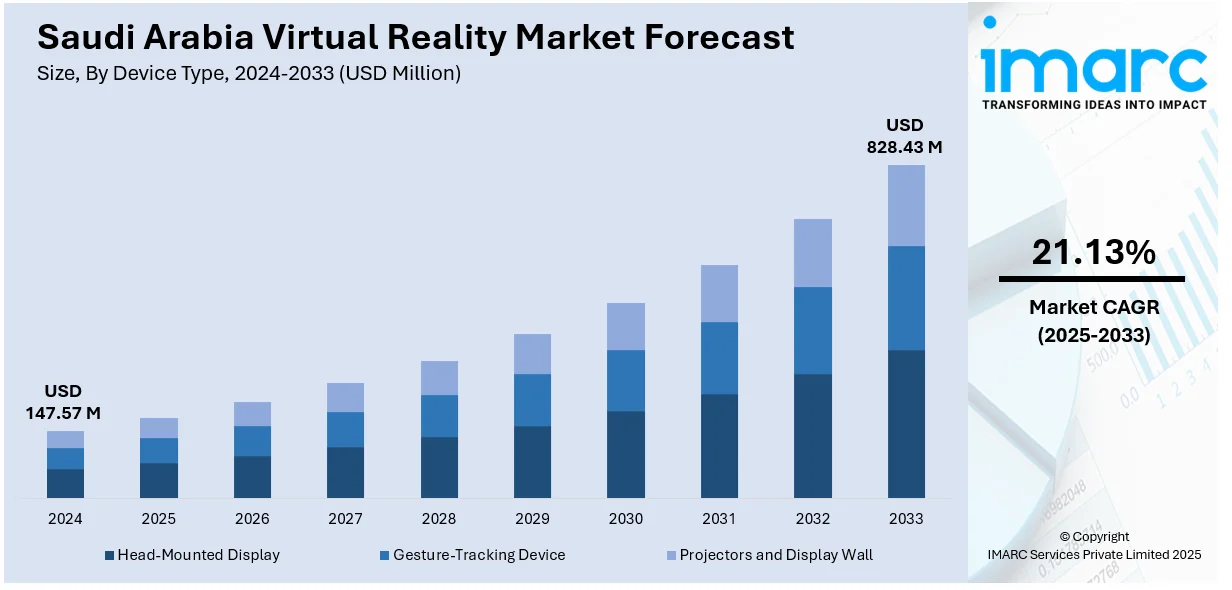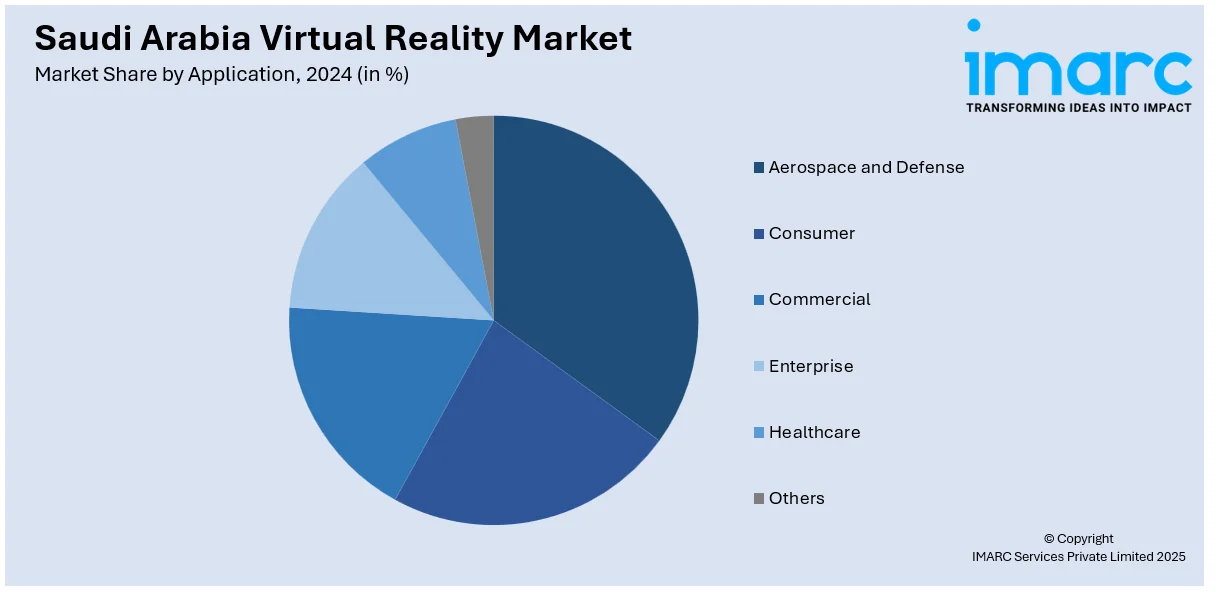
Saudi Arabia Virtual Reality Market Size, Share, Trends and Forecast by Device Type, Technology, Component, Application, and Region, 2025-2033
Saudi Arabia Virtual Reality Market Overview:
The Saudi Arabia virtual reality market size reached USD 147.57 Million in 2024. Looking forward, IMARC Group expects the market to reach USD 828.43 Million by 2033, exhibiting a growth rate (CAGR) of 21.13% during 2025-2033. The market includes strong government support through Vision 2030, increasing demand for digital transformation across sectors, and rising consumer interest in immersive experiences. Investments in tech infrastructure and education, along with growing private sector innovation, are further impelling the Saudi Arabia virtual reality market share.
|
Report Attribute
|
Key Statistics
|
|---|---|
|
Base Year
|
2024 |
|
Forecast Years
|
2025-2033
|
|
Historical Years
|
2019-2024
|
| Market Size in 2024 | USD 147.57 Million |
| Market Forecast in 2033 | USD 828.43 Million |
| Market Growth Rate 2025-2033 | 21.13% |
Saudi Arabia Virtual Reality Market Trends:
Healthcare Embraces VR for Training and Treatment
In Saudi Arabia, the health industry is embracing virtual reality to upgrade medical training as well as patient care. Virtual reality enables medical practitioners to simulate operations, make diagnoses, and rehearse emergency procedures in controlled, safe environments. This is better decision-making and minimizing the risks associated with training. To patients, virtual reality (VR) is used more in managing pain, physical rehabilitation, and mental therapy, providing interactive situations that aid faster and better recovery. The increasing emphasis on quality healthcare services, combined with government-supported innovation, is motivating hospitals and clinics to incorporate VR into their daily operations, revolutionizing the delivery of healthcare nationwide.

Government Drives VR Integration Across Sectors
The government of Saudi Arabia is at the forefront of the use of virtual reality (VR) through making digital innovation a key pillar of its national development strategy. Strategic backing, policy changes, and initiatives such as Vision 2030 are facilitating the adoption of VR in major sectors such as education, tourism, and entertainment. In schools, students employ VR to learn science and history through experiential learning. The tourism industry is also using VR and AR to increase the level of visitor engagement, as part of the National Tourism Strategy's vision of achieving 100 million visits per year. Virtual tours of cultural attractions provide worldwide audiences with an immersive view into the heritage of the Kingdom. Leisure events, like Riyadh Season, are incorporating VR experiences to attract tech-aware audiences. The governmental push is encouraging digital transformation and the development of a knowledge-based economy.
Retail Shifts to Immersive Consumer Experiences
Saudi Arabian retailers are embracing VR to develop engaging and immersive shopping experiences. Rather than using traditional stores or typical online sites, brands are providing virtual showrooms where customers can browse products as if they were in-store. These experiences enable shoppers to see products in real-life environments, enhancing buying confidence and customer satisfaction. This change not only improves consumer experience but also gives retailers an edge in a competitive marketplace. With increasingly tech-savvy consumers demanding personalized and convenient services, the application of VR in retail is quickly becoming business as usual, thus revolutionizing the Saudi Arabia virtual reality market growth.
Saudi Arabia Virtual Reality Market Segmentation:
IMARC Group provides an analysis of the key trends in each segment of the market, along with forecasts at the country and regional levels for 2025-2033. Our report has categorized the market based on device type, technology, component, and application.
Device Type Insights:
- Head-Mounted Display
- Gesture-Tracking Device
- Projectors and Display Wall
The report has provided a detailed breakup and analysis of the market based on the device type. This includes head-mounted display, gesture-tracking device, and projectors and display wall.
Technology Insights:
- Semi and Fully Immersive
- Non-Immersive
A detailed breakup and analysis of the market based on the technology have also been provided in the report. This includes semi and fully immersive and non-immersive.
Component Insights:
- Hardware
- Software
The report has provided a detailed breakup and analysis of the market based on the component. This includes hardware and software.
Application Insights:

- Aerospace and Defense
- Consumer
- Commercial
- Enterprise
- Healthcare
- Others
A detailed breakup and analysis of the market based on the application have also been provided in the report. This includes aerospace and defense, consumer, commercial, enterprise, healthcare, and others.
Regional Insights:
- Northern and Central Region
- Western Region
- Eastern Region
- Southern Region
The report has also provided a comprehensive analysis of all the major regional markets, which include Northern and Central, Western, Eastern, and Southern Region.
Competitive Landscape:
The market research report has also provided a comprehensive analysis of the competitive landscape. Competitive analysis such as market structure, key player positioning, top winning strategies, competitive dashboard, and company evaluation quadrant has been covered in the report. Also, detailed profiles of all major companies have been provided.
Saudi Arabia Virtual Reality Market News:
- In February 2024, The Saudi Ministry of Culture launched the world’s first National Cultural Metaverse Platform, offering immersive virtual reality history tours and cultural experiences. Developed with droppGroup and powered by GMI technology and blockchain, the platform features interactive attractions, live performances, and mini-games. Accessible on various devices, it aims to make Saudi heritage globally accessible, marking a significant advancement in digital cultural engagement and celebrating the Kingdom’s Founding Day.
- In July 2024, 5dVR, a Cairo-based VR and AR content studio, expanded to Saudi Arabia in partnership with AstroLabs to support the Kingdom’s digital transformation. The company aims to create immersive experiences across sectors like education, healthcare, and cultural heritage. With plans to collaborate with local institutions and tailor content to the Saudi curriculum, 5dVR seeks to drive innovation in line with Vision 2030 and strengthen the country’s growing immersive tech ecosystem.
Saudi Arabia Virtual Reality Market Report Coverage:
| Report Features | Details |
|---|---|
| Base Year of the Analysis | 2024 |
| Historical Period | 2019-2024 |
| Forecast Period | 2025-2033 |
| Units | Million USD |
| Scope of the Report | Exploration of Historical Trends and Market Outlook, Industry Catalysts and Challenges, Segment-Wise Historical and Future Market Assessment:
|
| Device Types Covered | Head-Mounted Display, Gesture-Tracking Device, Projectors and Display Wall |
| Technologies Covered | Semi and Fully Immersive, Non-Immersive |
| Components Covered | Hardware, Software |
| Applications Covered | Aerospace and Defense, Consumer, Commercial, Enterprise, Healthcare, Others |
| Regions Covered | Northern and Central Region, Western Region, Eastern Region, Southern Region |
| Customization Scope | 10% Free Customization |
| Post-Sale Analyst Support | 10-12 Weeks |
| Delivery Format | PDF and Excel through Email (We can also provide the editable version of the report in PPT/Word format on special request) |
Key Questions Answered in This Report:
- How has the Saudi Arabia virtual reality market performed so far and how will it perform in the coming years?
- What is the breakup of the Saudi Arabia virtual reality market on the basis of device type?
- What is the breakup of the Saudi Arabia virtual reality market on the basis of technology?
- What is the breakup of the Saudi Arabia virtual reality market on the basis of component?
- What is the breakup of the Saudi Arabia virtual reality market on the basis of application?
- What is the breakup of the Saudi Arabia virtual reality market on the basis of region?
- What are the various stages in the value chain of the Saudi Arabia virtual reality market?
- What are the key driving factors and challenges in the Saudi Arabia virtual reality market?
- What is the structure of the Saudi Arabia virtual reality market and who are the key players?
- What is the degree of competition in the Saudi Arabia virtual reality market?
Key Benefits for Stakeholders:
- IMARC’s industry report offers a comprehensive quantitative analysis of various market segments, historical and current market trends, market forecasts, and dynamics of the Saudi Arabia virtual reality market from 2019-2033.
- The research report provides the latest information on the market drivers, challenges, and opportunities in the Saudi Arabia virtual reality market.
- Porter's five forces analysis assist stakeholders in assessing the impact of new entrants, competitive rivalry, supplier power, buyer power, and the threat of substitution. It helps stakeholders to analyze the level of competition within the Saudi Arabia virtual reality industry and its attractiveness.
- Competitive landscape allows stakeholders to understand their competitive environment and provides an insight into the current positions of key players in the market.
Need more help?
- Speak to our experienced analysts for insights on the current market scenarios.
- Include additional segments and countries to customize the report as per your requirement.
- Gain an unparalleled competitive advantage in your domain by understanding how to utilize the report and positively impacting your operations and revenue.
- For further assistance, please connect with our analysts.
 Request Customization
Request Customization
 Speak to an Analyst
Speak to an Analyst
 Request Brochure
Request Brochure
 Inquire Before Buying
Inquire Before Buying




.webp)




.webp)












